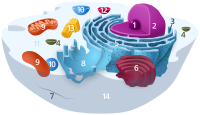
Photo from wikipedia
Asparagine-linked (N-linked) glycosylation is one of the most common protein modification reactions in eukaryotic cells, occurring upon the majority of proteins that enter the secretory pathway. X-ray crystal structures of… Click to show full abstract
Asparagine-linked (N-linked) glycosylation is one of the most common protein modification reactions in eukaryotic cells, occurring upon the majority of proteins that enter the secretory pathway. X-ray crystal structures of the single subunit OSTs from eubacterial and archaebacterial organisms revealed the location of donor and acceptor substrate binding sites and provided the basis for a catalytic mechanism. Cryoelectron microscopy structures of the octameric yeast OST provided substantial insight into the organization and assembly of the multisubunit oligosaccharyltransferases. Furthermore, the cryoelectron microscopy structure of a complex consisting of a mammalian OST complex, the protein translocation channel and a translating ribosome revealed new insight into the mechanism of cotranslational glycosylation.
Journal Title: Glycobiology
Year Published: 2019
Link to full text (if available)
Share on Social Media: Sign Up to like & get
recommendations!